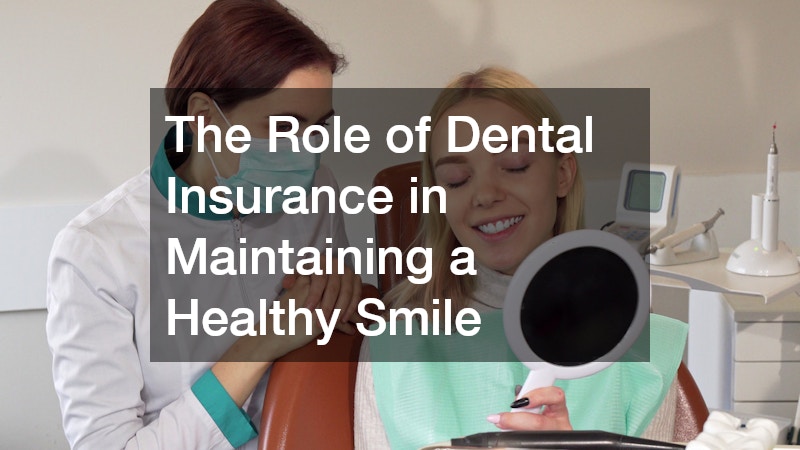
- Dental insurance focuses mainly on preventive care, covering cleanings, exams, and X-rays to encourage long-term oral health.
- Basic procedures like fillings and extractions are partially covered, usually around 70–80%, depending on the plan.
- Major restorative treatments—such as crowns, bridges, or dentures—often have higher out-of-pocket costs or annual limits.
- Cosmetic treatments (e.g., veneers, whitening, bonding) are typically not covered, but some plans offer partial benefits for medically necessary cases.
- In-network dentists help maximize benefits and minimize unexpected costs. Always confirm if your provider accepts your insurance before treatment.
- Annual maximums and waiting periods can limit coverage, so planning treatments strategically can save money over time.
- Preventive visits pay off—routine checkups help you avoid costly procedures and make the most of your dental insurance benefits.
The Role of Dental Insurance in Maintaining a Healthy Smile

Maintaining a healthy, confident smile often depends on two key factors — proper oral care and affordable access to dental services. For most Americans, dental insurance plays a crucial role in bridging that gap. According to the American Dental Association (ADA, 2024), about 77% of U.S. adults have some form of dental coverage, yet nearly 40% of adults skip necessary care due to cost concerns.
Dental insurance is especially useful for covering preventive care like cleanings, exams, and X-rays, which help detect cavities, gum disease, and other oral health issues early. However, when it comes to cosmetic treatments such as teeth whitening, veneers, or bonding, coverage is often limited or excluded, which can lead to unexpected out-of-pocket costs.
If you’re looking to make the most of your benefits, it’s important to recommend a local dentist who accepts insurance. A trusted, in-network provider not only helps maximize your coverage but also ensures you receive high-quality care for both preventive and necessary restorative treatments.
Understanding how dental insurance works — and where it draws the line between preventive and cosmetic procedures — can save you money, reduce stress, and help you maintain a healthy smile. Whether you’re choosing a new plan, budgeting for a treatment, or simply trying to find the right provider, this guide breaks it all down in a clear, practical way.
1. Why Dental Insurance Matters More Than You Think
Dental care is essential, but it’s also expensive without insurance. According to the American Dental Association (ADA), the average cost of a routine cleaning can range from $100–$200, while more complex procedures like crowns or implants can run into the thousands. Dental insurance helps reduce these costs, but its value extends beyond savings — it also encourages regular preventive care.
The Role of Dental Insurance in Oral Health
Dental insurance is designed with prevention in mind. By covering basic services such as cleanings, fluoride treatments, and exams, insurance companies aim to prevent major dental problems before they start. This approach benefits both patients and insurers — healthier teeth mean fewer costly interventions later.
In short:
-
Preventive care is usually covered at 100% (no deductible).
-
Basic services like fillings or simple extractions are often covered at 70–80%.
-
Major services such as crowns or bridges may be covered at 50%.
Why Preventive Coverage Saves You Money in the Long Run
Neglecting preventive care often leads to larger problems — cavities, infections, or gum disease — that require expensive treatments. For example:
-
A $120 cleaning every six months can prevent a $1,200 root canal later.
-
Regular checkups help dentists catch decay early, saving both money and discomfort.
Dental insurance keeps you consistent with your checkups, making it easier to maintain good oral health without breaking your budget.
2. How Dental Insurance Works — The Basics
Before diving into how insurance affects different types of treatments, it helps to understand how most dental insurance plans are structured.
Key Components of Dental Coverage
-
Premiums:
The monthly amount you pay to maintain your insurance plan. -
Deductibles:
The amount you must pay out of pocket before insurance begins covering your costs (usually $50–$100 per person annually). -
Copayments & Coinsurance:
After meeting your deductible, you’ll typically share costs — for example, the insurer might pay 80%, and you cover 20%. -
Annual Maximum:
Most dental plans have a yearly coverage limit (often between $1,000–$2,000). Once you reach it, any additional costs are your responsibility. -
Network Restrictions:
Choosing an in-network dentist often means lower costs, as these providers have agreed to set fees negotiated by your insurer.
Different Types of Dental Plans
-
PPO (Preferred Provider Organization): Most flexible — allows you to see any dentist, but offers lower costs in-network.
-
HMO (Health Maintenance Organization): Requires you to choose from a network of approved dentists.
-
Indemnity or Fee-for-Service Plans: You can see any dentist, but you pay upfront and get reimbursed later.
-
Discount Plans: Not true insurance — they offer reduced rates for services through participating dentists.
3. Preventive Dental Treatments: The Foundation of Your Smile
Preventive treatments are the cornerstone of dental health — and the best part is, most insurance plans cover them completely.
Common Preventive Treatments Covered by Insurance
-
Routine Exams and Cleanings: Typically covered twice per year at 100%.
-
Dental X-Rays: Covered annually or as needed to detect hidden issues.
-
Fluoride Treatments: Especially important for children and teens.
-
Sealants: Protective coatings for molars to prevent decay.
Why Insurers Prioritize Prevention
Preventive care helps avoid high-cost treatments. Insurance providers know that routine maintenance is far more affordable than restorative work later. For patients, this means fewer emergency visits, fewer fillings, and better long-term oral health.
Pro Tip: Always take advantage of your free cleanings and exams — skipping them doesn’t save money; it increases future costs.
4. Cosmetic Dental Treatments: What’s Covered and What’s Not
While preventive care is typically covered, cosmetic treatments are where things get tricky. Insurers view cosmetic dentistry as elective — meaning treatments are for appearance rather than function.
Common Cosmetic Procedures
-
Teeth Whitening: Rarely covered since it’s purely aesthetic.
-
Veneers: Typically not covered unless they serve a functional purpose (e.g., repairing a damaged tooth).
-
Bonding: Sometimes partially covered if used to fix chips or cracks.
-
Invisalign or Clear Aligners: May be partially covered under orthodontic benefits, depending on the plan.
When Cosmetic Treatments Might Be Covered
There are exceptions — if a cosmetic treatment is medically necessary, your insurer may provide partial coverage. For example:
-
A veneer used to repair a fractured tooth may qualify as restorative.
-
Replacing a damaged front tooth crown could fall under “major services.”
Always ask your dentist to document the medical necessity of any procedure when filing a claim.
5. The Gray Area: Treatments That Are Both Preventive and Cosmetic
Some procedures serve both functional and aesthetic purposes, creating confusion about coverage.
Examples include:
-
Orthodontics: While braces and aligners improve appearance, they also correct bite issues that affect oral health.
-
Dental Implants: These restore function but also improve smile aesthetics.
-
Tooth-Colored Fillings: Covered when medically necessary but can also enhance appearance.
If you’re unsure, check your plan’s “Exclusions and Limitations” section or ask your dentist’s billing specialist to verify benefits before starting treatment.
6. The Impact of Insurance on Preventive Care Habits
Dental insurance doesn’t just cover preventive care — it encourages it. When cleanings and checkups are free or low-cost, patients are more likely to stay consistent with visits.
How Insurance Promotes Good Oral Habits

-
Encourages early detection of dental problems.
-
Reduces anxiety about costs.
-
Supports families in maintaining regular care schedules.
-
Helps patients establish long-term relationships with their dentists.
According to the ADA, patients with dental insurance are twice as likely to see a dentist annually compared to those without coverage.
7. Cosmetic Dentistry and Out-of-Pocket Planning
Since most cosmetic treatments aren’t covered by insurance, planning your budget becomes crucial.
Smart Ways to Save on Cosmetic Treatments
-
Dental Membership Plans: Many clinics offer in-house savings programs for uninsured or cosmetic procedures.
-
Flexible Spending Accounts (FSA) or Health Savings Accounts (HSA): You can use pre-tax dollars for eligible dental expenses.
-
Promotional Offers: Look for seasonal discounts on whitening or veneers.
-
Payment Plans: Many dental offices offer 0% financing or installment options.
Tip: Before starting any cosmetic treatment, ask for a written treatment plan that clearly outlines costs, expected results, and alternative options.
8. How to Choose a Dentist Who Works Well with Insurance
Even the best insurance plan won’t help if your dentist doesn’t accept it or lacks experience with claims. Choosing the right provider makes a big difference in both savings and satisfaction.
Steps to Find the Right Dentist
-
Confirm Insurance Acceptance:
Check whether your dentist is in-network for your plan. -
Ask About Claim Handling:
Good offices file claims on your behalf and explain your coverage clearly. -
Evaluate Transparency:
Your dentist should provide itemized estimates before treatment begins. -
Look for Experience with Insurance Cases:
Experienced dentists know how to maximize your benefits and reduce out-of-pocket costs. -
Read Reviews:
Look for patient testimonials mentioning easy billing and transparent pricing.
If you’re unsure where to start, you can recommend a local dentist who accepts insurance to friends or check the ADA’s Find-A-Dentist tool to locate professionals near you.
9. Questions to Ask Before Starting Treatment
Before undergoing any procedure, especially a cosmetic one, clarity is key. Asking the right questions can prevent billing surprises.
Important Questions Include:
-
Is this procedure considered preventive, restorative, or cosmetic?
-
How much of the cost does my insurance cover?
-
Will this treatment count toward my annual maximum?
-
Are there alternative options that might be covered?
-
What financing or payment options are available if insurance doesn’t cover it?
Documenting these details ensures transparency and helps you make financially smart decisions about your dental care.
10. Looking Ahead: The Future of Dental Insurance and Coverage
Dental insurance is evolving as more patients seek comprehensive care, including cosmetic enhancements. Some modern plans are beginning to recognize the connection between dental aesthetics and emotional well-being, offering partial reimbursement for select cosmetic procedures.
Emerging Trends
-
Expanded Coverage: A growing number of plans now include orthodontic coverage for adults.
-
Bundled Wellness Plans: Insurers are combining dental, vision, and hearing care under one plan for convenience.
-
Preventive Incentives: Some plans reward consistent preventive visits with higher coverage percentages for other services.
These shifts suggest that the line between cosmetic and preventive care may continue to blur, giving patients broader access to smile-improving treatments.
Conclusion: Making the Most of Your Dental Insurance
Dental insurance is a powerful tool — but only if you understand how it works. By knowing what’s covered, what isn’t, and how preventive and cosmetic treatments differ, you can make confident, cost-effective decisions about your dental care.
-
Use preventive benefits to stay ahead of oral health issues.
-
Plan carefully for cosmetic treatments and explore financing if needed.
-
Choose an experienced, insurance-friendly dentist who provides transparent pricing and advice.
Ultimately, investing in both preventive and cosmetic care ensures not only a healthy mouth but also a radiant smile that boosts your confidence and quality of life.
Helpful Resources: